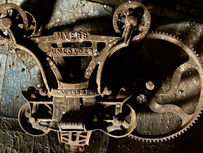History of Alasa Farms
Alasa Farms has gone by many names over the years, including the Sodus Bay Shaker Tract, Sodus Bay Phalanx, and Cracker Box Palace, depending on who owned or operated it.
The first settler to the site was Judge John Nicholas of Virginia who built the first mills on Second Creek as well as establishing a settlement between Nicholas Point and the current Alasa Farms site. On June 19th 1813, during the British incursion at Sodus Point, Judge Nicholas’ storehouses and wharves were razed.
In 1826, the heirs of Judge Nicholas sold the property to the Sodus Bay Shakers, an official branch of the United Society of Believers in Christ's Second Appearing. This industrious group committed to communal service and worship. In 1836, the Sodus Bay Canal Company purchased the property for their ultimately unsuccessful goal of connecting Sodus Bay with the Erie Canal, while the Sodus Bay Shakers moved to a new community in Groveland.

The property was also home to the Sodus Bay Phalanx of the Fourier Society. This group was devoted to establishing utopian communities based on communal living. They did not stay for long, lasting only two years before leaving the property in 1846, where it reverted back to the Sodus Bay Canal Company until 1868 when Dewitt Parshall bought the farm, with it staying under his family’s ownership until its purchase by Strong and McBride.

In 1926, the farm was bought by a partnership of Alvah Strong and Asa McBride, naming it Alasa Farms as an amalgamation of their names. In the following years, the Strong family bought out McBride to be the sole owners of the farm.
The farm stayed under Strong family ownership throughout the 20th-century, but the farm’s road to its current ownership began in 2003. The nearby Cracker Box Palace was beginning to grow exponentially, and was running out of room for new animals. Seeing this, Alasa Farms owner Griff Mangan offered for the Palace to expand into his farmland.
2009 would be an important year in the farm’s history in ways both bad and good. The National Register of Historic Places would list the farm that year, bringing more attention both to Alasa Farms and Cracker Box Palace. Unfortunately, there was also a damaging fire that year that ravaged the Main House, an original Shaker building that was erected in 1828.
In 2011 Alasa Farm's journey through history took an important and transformational turn. The farm had been put up for sale by the private owners. The community came together to secure the funding needed to permit sale and transfer to a nonprofit corporation charged with moving the farm into the future in ways that would benefit the public.
.jpeg)
The organization handed the larger mission was a familiar one: Cracker Box Palace, the nonprofit that had been leasing space at the farm for its long standing large animal shelter. Thus, with the stroke of a pen, Alasa Farms found itself with a new owner, and Cracker Box Palace found itself with mission responsibilities including not only its animal shelter but also the farm's historic and natural assets.
Our journey through history continues. Where history is concerned we have an obligation to preserve and protect our historic assets. And we want to tell stories, not only about the farm itself but about the very interesting history that gave rise to the many things that happened here. We need help to do this: people willing to work on our buildings, docents interested in telling our stories to visitors, and donors ready to support our ambitious efforts to restore our important historic assets and create programs to educate the public.
Do you have photos or stories about Alasa Farms?
Please let us know; we’d love to hear from you!
-03.png)









